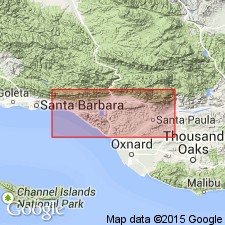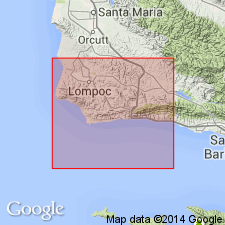
- Usage in publication:
-
- Cozy Dell shale member
- Modifications:
-
- Original reference
- Dominant lithology:
-
- Shale
- Sandstone
- AAPG geologic province:
-
- Santa Maria basin
- Ventura basin
- [Los Angeles basin(?)]
Summary:
Pg. 1090. Cozy Dell shale member of Tejon formation. The rhythmically bedded, fossiliferous, marine, green micaceous shale and sandstone that is typically exposed in Cozy Dell Canyon, on east side of Ventura River, [Ventura 15-min quadrangle], Ventura County, southern California, and forms middle member of Tejon formation. Thickness 2,500+/- feet. Underlies Coldwater sandstone member and disconformably overlies Matilija sandstone member [both of Tejon formation]. Age is Eocene.
Source: US geologic names lexicon (USGS Bull. 896, p. 536).
- Usage in publication:
-
- Cozy Dell shale [member]
- Modifications:
-
- Age modified
- Biostratigraphic dating
- AAPG geologic province:
-
- Ventura basin
Bailey, T.L., 1947, Origin and migration of oil into Sespe redbeds, California: American Association of Petroleum Geologists Bulletin, v. 31, no. 11, p. 1913-1935.
Summary:
Pg. 1931-1932. Cozy Dell shale [member] of Tejon shales. Recognized in Santa Barbara and Ventura Counties, southern California. Large seepages of tarry oil issue from this unit. Thickness ranges from a few hundred feet in Gaviota Canyon area to 3,200 feet north of Ojai. Underlies Coldwater sandstone [member] of Tejon shales. Fossils. Contains a prolific Tejon fauna which establish its age as [late] Eocene. Characteristic species are TURRITELLA UVASANA (typical) var. T. SARGEANTI, PECTEN CALKINSI, FICOPSIS HORNII, PSEUDOPERISSOLAX CALLISTA CONRADIANA, and PITARIA TEJONENSIS. Other fossils are Foraminifera, fish scales, strap-like rushes, and marine algae (kelp-like plants).
Source: Publication; US geologic names lexicon (USGS Bull. 1200, p. 968-969).

- Usage in publication:
-
- Cozy Dell shale
- Modifications:
-
- Areal extent
- [Revised]
- AAPG geologic province:
-
- Santa Maria basin
Summary:
Pg. 24, 27-28, 38 (fig. 2), pls. 1-6. Cozy Dell shale. [Rasied to formation rank.] Rocks previously mapped as Tejon Formation (not used). Described in Santa Ynez Mountains, Santa Barbara County, southern California, as well-bedded brown clay shale lying conformably on the Matilija sandstone and grading upward through a series of thin sandstone interbeds into the overlying Sacate sandstone. Thickness 700 to 2,000 feet. Fossils. Lower half of formation yielded Foraminifera correlative with Laining's zone A-2 (citing Kelley, F.R., 1943, AAPG Bull., v. 27, no. 1, p. 1-19); upper half of formation barren of diagnostic fossils. Age is late Eocene [based on fossils].
Source: Publication; US geologic names lexicon (USGS Bull. 1200, p. 968-969).
For more information, please contact Nancy Stamm, Geologic Names Committee Secretary.
Asterisk (*) indicates published by U.S. Geological Survey authors.
"No current usage" (†) implies that a name has been abandoned or has fallen into disuse. Former usage and, if known, replacement name given in parentheses ( ).
Slash (/) indicates name conflicts with nomenclatural guidelines (CSN, 1933; ACSN, 1961, 1970; NACSN, 1983, 2005, 2021). May be explained within brackets ([ ]).

